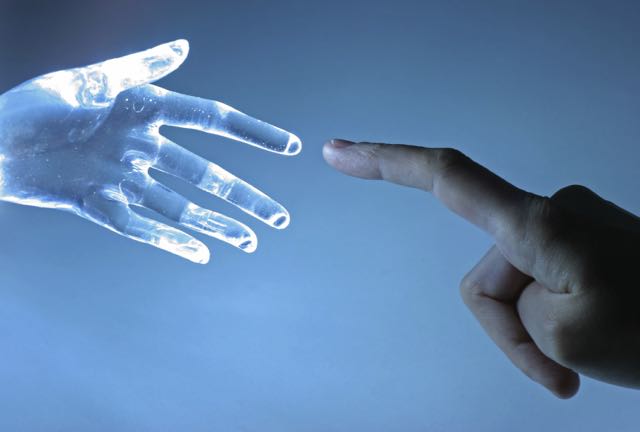A magazine where the digital world meets the real world.
On the web
- Home
- Browse by date
- Browse by topic
- Enter the maze
- Follow our blog
- Follow us on Twitter
- Resources for teachers
- Subscribe
In print
What is cs4fn?
- About us
- Contact us
- Partners
- Privacy and cookies
- Copyright and contributions
- Links to other fun sites
- Complete our questionnaire, give us feedback
Search:
Tickle my rubber hand
by Jane Waite, Queen Mary University of London

Take a rubber hand, two tickling sticks, a box and two people, one the 'tickler' the other the 'ticklee'. The 'ticklee' hides both hands in the box. But above their left hand, the tickler puts a rubber left hand so that it looks like it has replaced the real left hand. The ticklee can see their rubber left hand but not their own hands. The tickler then sets to work and tickles both the rubber left hand, in plain sight, and the hidden right hand. What do you think happens?
Might the ticklee think they now have a rubber hand that is being tickled?
The rubber hand illusion was created in 1990 by researchers looking at how our brains predict whether what they see or feel is right. The rubber hand gives our brains a multimodal conundrum. We can see a rubber hand being tickled, and we can feel our other hand being tickled. Logically we know our left hand is not being tickled, but our senses seem to be telling us otherwise. Researchers have repeated this over and over and most people think, yep, they can feel the rubber hand being tickled. The way our brains make predictions based on combined information from the different senses leaves us with a powerful illusion. Freaky!
Illusion? What illusion?
An Australian team are using the rubber hand illusion to understand people with Autism. They found that they don't fall for the trick! Why? It might be that they don't associate this new strange experience of a rubber hand with what normally happens when you are tickled. Their brains therefore don't predict it will tickle.
With more experiments the researchers will get a better understanding of how autistic people make these subconscious predictions about the world. Ultimately this could help people with Autism make sense of the world. It might also help us change how things work so they are easier for those with Autism to predict.
Make it predictable
Good design is predictable. As you walk along the road lost in your headphone music, you feel bobbles under your feet and stop, looking around: you realised you were at a road. You are standing at a pelican crossing and see a red man flashing. You predict, without much thought, that the lights you can't see won't stop the approaching cars, so you wait. A green man and bleeps lead you to predict the cars will stop, even though the drivers can't see your light and you can't see theirs. You predict you can step out in to the road and won't get splattered over a car bonnet.
A crossing is a multimodal system. The bumpy ground and beeps are designed to help the partially sighted, though they often help the rest of us too.
Now think! Suppose you have autism. What do these different sounds, sights even textures of the buttons and the floor near the crossing mean? What will you predict will happen? How will you respond? Do these multimodal cues work for people with autism given they sense the world in a different way? Perhaps we could design them even better and help even more people.
A pelican crossing is fairly simple, but as computer scientists make ever more complex multimodal systems, they need to be sure they understand how our brains will react, autistic or otherwise. The rubber hand illusion shows it isn't always obvious. One person's surefire prediction might be another's bafflement. The more we know of how our brains really work the more chance we will think of ways to design everyday machines so they work well for everyone.
The Australian rubber hand gang's findings might seem to be a trick, but actually the magic is in what they find out about our senses, and how that might one day lead to ideas for better design.


